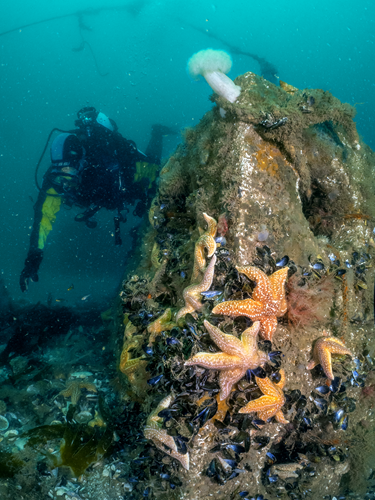An artificial reef has been installed at a wind farm off the Sussex coast to protect turbine foundations – and nurture marine habitats.
The project at the Rampion Offshore Wind Farm has seen 75,000 “Reef cubes” placed at the bottom of one of the site’s turbines.
RWE and UK-based ARC marine say they have achieved a “global first” with the initiative.
The pioneering solution is designed to protect the critical energy infrastructure from strong currents in the subsea environment, while creating new and extending existing living marine habitats.

Reef cubes ranging in size from 15cm to 35cm, were installed at the base of one of the turbines by specialist contractor Rohde Nielsen. It is the first real-world deployment of the patented Reef cubes as scour protection at an operational wind farm, and forms part of the Reef Enhancement for Scour Protection (RESP) pilot3. It follows an earlier announcement in July of RWE and ARC marine’s partnership.
Thomas Michel, COO of RWE Offshore Wind, said: “We are delighted to have reached this important milestone at Rampion in collaboration with our partners ARC marine and Rohde Nielsen. The successful implementation of this pilot project marks an important step forward in testing solutions that can both safeguard our assets and contribute to the marine environment. We look forward to monitoring the outcomes and sharing the learnings with our stakeholders and the wider industry.”
Use of scour protection is standard practice at offshore wind farms and usually involves placing layers of rock on the seabed around the base of a turbine foundation.
Reef cubes offer an alternative that provides equally effective protection from erosion but also enhanced biodiversity.
They are modular, lighter, easy to install and designed to turn protection zones into thriving ecosystems. The structure of the cubes provides habitats for marine life, supports fish populations, shellfish colonisation and broader ecosystem development.
At just one of the Rampion turbines, the Reef cubes are providing a habitat surface area of 25,000 square metres.
Tom Birbeck, CEO of ARC marine, said: “This project is a landmark moment for ARC marine and our Reef cubes technology. By using a patented shape and optimised surface texture, the Reef cubes provide over 100% more volume of habitat spaces than standard rock protection and 38% more surface area.
“Seeing them installed at Rampion demonstrates their potential to deliver dual benefits: robust scour protection and the creation of new marine habitats. This installation marks the start of global deployment potential for Reef cubes at offshore turbines and platforms.
“They are scalable, locally sourced, cost-effective and fully aligned with incoming biodiversity net gain requirements and we are proud to work with RWE on pioneering a new generation of nature-inclusive offshore wind solutions.”
The use of the Reef cubes is aligned with RWE’s commitment to delivering biodiversity-positive offshore wind farms and this collaborative pilot has been designed to test and advance solutions that can deliver both engineering performance and environmental benefits.
The RESP pilot will next move into a monitoring phase. Ecological and geophysical surveys will be conducted between 2026 and 2030 to assess the cubes’ performance as a scour protection system and to study how marine life interacts with the structures over time. Ecological and engineering data will be shared from 2026, offering a first glimpse at the real-world viability of nature-inclusive protection structures.

